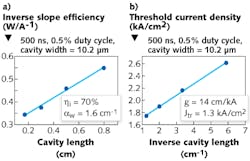QUANTUM-CASCADE LASERS: Long-wavelength QCL emits 2 W at 9 μm
Long-wavelength quantum-cascade lasers (QCLs) with record-high pulsed and continuous-wave (CW), room-temperature wall-plug efficiencies of 16% and 10% have been created by researchers at Pranalytica (Santa Monica, CA) and the University of California–Los Angeles.1 The achievement was augmented by the fact that predictions from a refined laser model based on rate equations were consistent with the experimental results—giving the researchers confidence that they could use the model to predict future results.
The laser design has a nonresonant-extraction, 45-stage QCL active region emitting at 9 μm and based on a strain-balanced indium gallium arsenide/aluminum indium arsenide (In0.58Ga0.42As/Al0.64In0.36As) structure with strains of 0.36% in the quantum wells and -1.10% in the barriers. The laser chips are mounted on aluminum nitride/silicon carbide composite submounts.
The laser’s optical waveguide has a low (2 × 1016 cm-3) doping level in the 3 μm cladding layers, which lowers free-carrier waveguide optical losses to 1.1 cm-1; the optical mode overlap with the active region is 52%. A highly doped (8 ×1018 cm-3), 1 μm plasmon layer is placed between the QCL layers and the metal top contact, which helps to decouple the laser’s optical mode from the absorbing contact.
At 293 K, a 3 mm × 10 μm laser chip with uncoated facets produced a maximum optical power of 4.4 W in pulsed operation (500 ns pulses and 0.5% duty cycle) and 2.0 W in CW operation. Threshold current densities were 2.1 and 2.5 kA/cm2, respectively, and slope efficiencies were 2.8 and 2.1 W/A, respectively. The researchers note that the optical powers and efficiencies are more than a factor of two higher than other previously reported results for similar QCLs.
Semiempirical model
The model is actually semiempirical, as one parameter—the injection efficiency term—still cannot be predicted. This term can be extracted from data on laser slope efficiency and threshold current density as a function of cavity length (see figure). The experimentally determined value of 70% for the injection efficiency led to accurate predictions in the model for both the differential gain and the transparency current, showing the consistency of the model.
Because the equation is so useful, the researchers would like to make it even broader in reach by including the injection efficiency in the model in a less empirical way. The injection efficiency could be assumed to be 100%, as this goal could become realistic in practice, say the researchers. Also, a detailed study of the mechanisms of injection efficiency could help to flesh out the model.
The difference between the waveguide losses (1.6 cm-1) and the free-carrier losses (1.1 cm-1) is 0.5 cm-1, which is less than 10% of the laser’s total losses. This is important because it means that, as far as losses go, the model need only take into account the easily calculable free-carrier absorption.
The resulting laser is powerful and efficient; the fact that it can be thoroughly modeled will aid in future development of even more powerful long-wavelength QCLs for gas sensing and free-space communications.
REFERENCE
1. A. Lyakh et al., Opt. Exp., 20, 22, 24272 (Oct. 22, 2012).

John Wallace | Senior Technical Editor (1998-2022)
John Wallace was with Laser Focus World for nearly 25 years, retiring in late June 2022. He obtained a bachelor's degree in mechanical engineering and physics at Rutgers University and a master's in optical engineering at the University of Rochester. Before becoming an editor, John worked as an engineer at RCA, Exxon, Eastman Kodak, and GCA Corporation.
